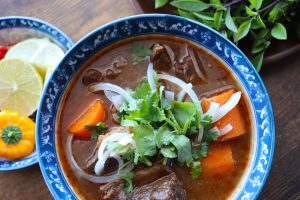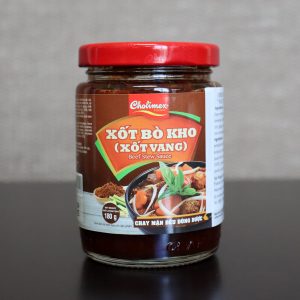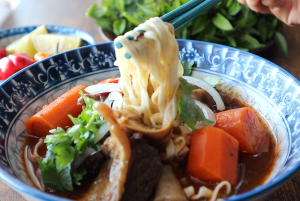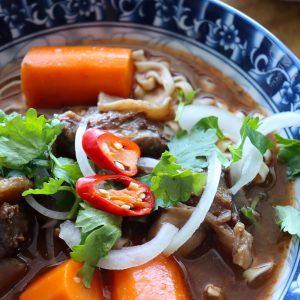Vietnamese Beef Stew (Bò Kho)

Almost every culture has its own version of beef stew, and Vietnam is no exception. Vietnamese Beef Stew (Bò Kho) originated in South Vietnam during the French colonial period. At that time, street food was immensely popular in Saigon, with vendors carrying yokes on their shoulders, balancing two heavy baskets filled with food. Bò Kho began as a humble street food but has grown in popularity over time. Some sources suggest that Bò Kho was influenced by Chinese culinary traditions in Vietnam, as it incorporates a variety of spices often associated with Chinese cuisine.
Bò Kho is a versatile dish that can be served in several ways: with steamed rice, French baguette (Bánh Mì Bò Kho), rice noodles (Hủ Tiếu Bò Kho), or egg noodles (Mì Bò Kho). When served with noodles, additional water is added to the stew to make it soupier.
Vietnamese Beef Stew is loved not only by the Vietnamese but also by people around the world. The ingredients are simple – beef, carrots, and sometimes daikon radish – but the dish is incredibly aromatic and flavourful, thanks to the array of aromatics such as lemongrass, ginger, star anise, bay leaves, garlic, shallots, and five-spice powder. After marinating for hours and then simmering slowly for over an hour, the beef absorbs all the flavours and becomes tender, sweet, and fragrant.
Today, many restaurants outside of Vietnam feature this beloved dish. Alongside Phở, Chả Giò, and Bánh Mì, Bò Kho is one of the most recognizable Vietnamese dishes internationally. Fortunately, this hearty and aromatic stew can also be made at home – perfect for a warm dinner or even breakfast on a cold winter morning.

Here are a few notes on my Vietnamese Beef Stew recipe:
- Many recipes suggest using “beef chuck” for Bò Kho. If you’re unsure about which cut of beef to choose, don’t hesitate to ask your local Asian or Vietnamese butcher – they can recommend the best option for Bò Kho. In my opinion, any cut of beef suitable for stewing works well, though I prefer a cut with some fat for added richness.
- The longer the beef marinates, the better the flavour. That’s why many people marinate the beef and leave it in the fridge overnight before cooking the stew the next day. For this recipe, I marinate the beef for about 3 hours (with a minimum of 2 hours).
- I use annatto oil to add a vibrant red colour to the Bò Kho (you can find my homemade recipe here). While it’s optional, it gives the stew a richer appearance and a bit of extra flavour if you have it on hand.
Q&As on Vietnamese Beef Stew
1. Is Bò Kho difficult to make? The list of ingredients seems a bit overwhelming for me.
Bò Kho might seem complex at first glance due to the number of ingredients, but it’s actually quite approachable! Many of the ingredients, like aromatics and spices, are added in stages, so you’re not dealing with everything all at once. Once you prep the ingredients, most of the cooking involves marinating the beef and then letting it simmer slowly, which allows the flavours to develop without requiring much hands-on time. With a bit of preparation and organization, you’ll find that making Bò Kho is quite manageable – and the delicious result is definitely worth the effort!

2. What is Vietnamese beef stew seasoning? Is it something I can find in my local Asian supermarket?
Vietnamese beef stew seasoning is a ready-made spice blend specifically for Bò Kho. In my recipe, I use just a small amount to enhance the flavour of the dish, as the majority of the flavour comes from stewing the lemongrass, ginger, bay leaves, and other aromatics. You can easily find this seasoning in most Asian supermarkets, and I’ve included a photo of it here. Don’t worry if you can’t find the exact brand – there are usually a few different options available. As long as it says it’s for Bò Kho, you’ll be good to go!
3. Can I just use the ready-made Vietnamese beef stew seasoning and skip the lemongrass, ginger, five-spice, etc.? I’m pretty sure the seasoning has all those ingredients.
While the ready-made Vietnamese beef stew seasoning does contain many of the key spices, I wouldn’t recommend skipping fresh ingredients like lemongrass, ginger, and five-spice. These aromatics bring a depth of flavour and fragrance that’s hard to replicate with just the seasoning blend. The seasoning is great for enhancing the flavour, but using fresh ingredients alongside it really makes the Bò Kho special.
4. I like to make Bánh Mì Bò Kho (Vietnamese Beef Stew with French Baguette). However, I don’t have access to a local Vietnamese bakery to get authentic Bánh Mì. Can I just substitute it with any bread?
While Vietnamese Bánh Mì is the traditional choice, the original French Baguette is equally delicious for Bánh Mì Bò Kho. The good news is that French Baguettes are widely available – almost any Walmart location carries them. In fact, I got the French Baguette for my Bò Kho from my local Walmart too! If you don’t have access to French Baguette, feel free to experiment with any other type of bread. Just be sure to toast it first before serving, as it adds a nice crunch and complements the rich flavours of the stew.

5. Can Bò Kho be stored in the fridge and consumed later?
Yes, Bò Kho can definitely be stored in the fridge and enjoyed later! In fact, like many other Vietnamese braised and stew dishes, such as Thịt Kho Tàu (Vietnamese Braised Pork & Eggs), Bò Kho often tastes even better the next day. As the stew sits, the meat continues to absorb more of the rich flavours from the broth, making it even more flavourful when reheated. It’s a great dish to prepare ahead of time and enjoy over a few days.
6. My Bò Kho is a bit soupy. I would like the broth to be a bit thicker – what should I do?
If you’d like your Bò Kho broth to be thicker, there are a couple of ways to achieve this. One option is to let the stew simmer uncovered for a longer period of time, allowing some of the liquid to evaporate and the broth to reduce and thicken naturally. Another method is to mix a little cornstarch with water to create a slurry, and then gradually stir it into the simmering broth. This will help thicken it without affecting the flavour. Start with a small amount of the slurry and adjust as needed until you reach your desired consistency.
7. How do you pronounce “Bò Kho?”
Bò Kho is pronounced as “Baw Khaw.” The word Bò means beef, and it’s pronounced with a low falling tone, similar to the word “baw” in “bottle,” but shorter and lower. Kho means to braise or stew, and it’s pronounced like “kaw” in “caught,” but with a slightly softer kh sound. The tonal nature of Vietnamese makes it distinct, so don’t worry if it takes a little practice to get it right!

Recipe for Vietnamese Beef Stew (Bò Kho)
Equipment
- 1 medium or large pot
Ingredients
For the Beef and the Marinade:
- 2 pounds boneless beef for stewing, cut into bite-sized chunks
- 2 tablespoons minced garlic
- 2 tablespoons minced shallots
- 2 tablespoons fish sauce
- 1 teaspoon MSG (or chicken bouillon powder)
- 1 teaspoon Vietnamese beef stew seasoning
- 2 teaspoons five-spice powder
For the Broth:
- 3 medium carrots
- 4 stalks fresh lemongrass
- 2 medium ginger roots
- 5 bay leaves
- 3 whole star anise
- 1 cup coconut juice
- 2 tablespoons tomato paste
- 1 tablespoon Vietnamese beef stew seasoning
- Seasoning: Fish sauce, salt, mushroom powder (to season the broth as needed)
- 2 tablespoons annatto oil optional
- Cornstarch optional
Garnishes (Optional):
- Coarsely chopped cilantro
- Thai basil
- Thinly sliced raw onions
- Fresh Thai chilis
Instructions
- Marinate the Beef:In a large mixing bowl, combine the beef chunks with fish sauce, MSG (or chicken bouillon powder), five-spice powder, Vietnamese beef stew seasoning, minced garlic, and shallots. Make sure all the beef pieces are evenly coated with the seasonings and aromatics.Let the beef marinate for at least two hours to allow the flavours to develop. For the best results, cover the bowl and refrigerate the beef overnight, giving it more time to absorb the seasonings.
- Prepare the Ingredients:Peel the carrots and cut them into bite-sized pieces.Slice the ginger into thin pieces, and smash the lemongrass stalks with the back of a knife or a heavy object. This will help release the oils and aroma from the lemongrass, which are essential for the broth’s fragrance.
- Cook the Broth:Heat a few tablespoons of oil in a large stockpot over high heat. Once the oil is hot, add the smashed lemongrass stalks. Let the lemongrass cook in the oil for about 1 minute so it infuses the oil with its bright, citrusy aroma.Add the marinated beef chunks to the pot. Brown the beef on all sides, stirring occasionally to ensure even cooking. Stir in the tomato paste, making sure it coats the beef evenly. Cook for about 2 minutes, stirring constantly, allowing the paste to caramelize slightly and deepen the colour and flavour of the stew.Add the sliced ginger, bay leaves, star anise, additional beef stew seasoning, coconut juice, and 6 cups of water to the pot. Stir everything together, and bring the mixture to a rolling boil. As it boils, skim off any impurities or foam that rise to the surface.If desired, add a couple of tablespoons of annatto oil to give the stew a vibrant red hue. Once the stew has reached a boil, reduce the heat to medium-low. Cover the pot and let it simmer gently for about 1 hour, allowing the flavours to meld and the beef to become tender.About 20 minutes before the stew is finished, carefully remove and discard the lemongrass, ginger slices, and star anise to prevent them from overpowering the broth.Taste the broth and adjust the seasoning as needed, adding more fish sauce or mushroom powder to suit your preference.Add the prepared carrot pieces to the stew and continue cooking until they’re tender, but not too soft, ensuring they maintain some texture.If you find the broth is too thin, mix 1 tablespoon of cornstarch with a small amount of water to make a slurry. Slowly pour the slurry into the stew while stirring constantly, allowing the broth to thicken to your desired consistency.
- Serve:Once the stew is ready, ladle it into serving bowls. Garnish with freshly chopped cilantro and thinly sliced raw onions if desired, adding a fresh, crisp contrast to the rich broth. Serve the stew alongside toasted French baguettes or steamed white rice for a comforting and hearty meal.If you prefer a noodle option, serve the stew with rice noodles or egg noodles. For this, you may want to thin the stew by adding a bit more chicken stock or water, adjusting the consistency to your liking. Don’t forget to adjust the seasoning as well to balance the flavours with the extra liquid.

